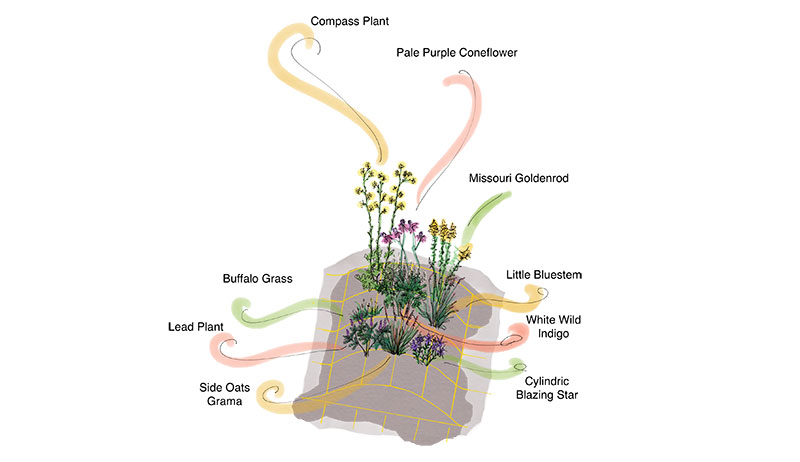
Whether you are a farmer, homesteader or urban green thumb, a spot of prairie is a great way to add diversity benefit to your property. Tall grass prairie once stretched across the United Stated and Canada, especially in the middle where it graduated from tall grass to medium and short grass as one walked west.
Now there is less than 1 percent of prairie left in North America. Why? Because it was the deepest, richest soil, and the land was flat and easy to plow into farmland.
So why not give back to this valuable ecosystem in a number of practical ways?
Large Grassland Farm
Tall grass prairie and rotational grazing makes some of the healthiest meat for cattle or bison.
Large Crop Farms
Include prairie as riparian buffers near streams and certified organic buffer strips between farms.
Medium-Scale Properties
Include prairie as alleyways between your fruit trees in orchards or as perimeter buffer zones for organic certification.
Restoration Projects
Use prairie plant species as the chosen varieties to rehabilitate an old gravel pit or industrial site.
Small Properties
Use prairie plants as an alternative lawn or to fill a back-field.
Urban Sites
Plant a small, 25-square foot spot to take a stand for this endangered ecosystem in your little piece of earth.
Read more: Ready to ditch your lawn for a grass-free yard? Here’s why you might and how to do it.
How to Plant a Prairie
The key ingredients for a tall grass prairie are the same as any ecosystem design. You need to understand your soil type, pH, how wet your site is and how much sun it gets.
(See my book The Edible Ecosystem Solution for a complete step-by-step process for converting any piece of land to a garden spot that is well set up for any ecosystem design.)
Next, choose prairie plants for your ecosystem design. Make sure to stagger them by both form and function. Include some that are nitrogen fixers (like wild indigo), some that make great bird habitat (like big bluestem), and some that serve as ground cover (like wild strawberry or pussy toes).
Include wild edibles like nodding onions and even a wild raspberry, too!
Also make sure you consider light access. Many prairie plants can grow up to 9 feet tall. If you are planting a small spot, these plants can be placed on the north side of the spot. Smaller plants can grow in front, stepping up the sizes to the back.
This also makes a very showy garden spot in your yard.
Below you’ll see a guild design intended as a template for how to plant a spot. This can, of course, be extrapolated to a large scale.
Buffalo Grass
- Very fast growing
- Does not like shade
- Warm-season grass
Compass Plant
- Can live for 100 years
- Can grow to 8 feet
- Plant on the north side of the site, as it will grow tall and capture light no matter what.
Pale Purple Coneflower
- Medicinal
- Beautiful flowers
Missouri Goldenrod
- Edible
- Restoration/rehabilitation plant
- Can grow in all sorts of poor soil conditions
Little Bluestem
- Ground cover for protecting the soil
- Great for birds, providing nesting material
- Warm-season grass
Wild White Indigo
- Nitrogen-fixing plant
Cylindrical Blazing Star
- Shallower roots
- Less competitive
- Good option over or near a septic field
Side Oats Grama
- Creeping rhizomes
- Warm-season grass
- A great soil protector
Lead Plant
- Nitrogen fixer
- Drought tolerant
- Hosts many species of butterflies
Buffalo Grass
- Very fast growing
- Doesn’t like shade (plant on south side of small spot designs)
- Warm-season grass
Tall grass prairie sequester carbon, build soil, provide habitat for endangered species and can create habitat for beneficial pollinators—all while creating a beautiful space that can also provide food for foraging and other wildcrafting.
For an organic farm, protecting streams and your water for livestock and irrigation, or creating a buffer for organic certification provide enough reason to put this grassland ecosystem into your planting plans.
But when you consider that planting a prairie can reduce your carbon footprint and sustain an endangered ecosystem that gave our society so much of its good soil … it’s a no-brainer to establish some prairie somewhere!
In our next article, we’ll look at how to go about planting an acre of prairie.
Grow On,
Zach




